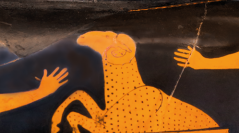

 Anthropozoologica
59 (3) - Pages 29-35
Anthropozoologica
59 (3) - Pages 29-35The Arab traveller Abū l-Ḥāmid al-Ġarnaṭī (1080-1169) travelled through the Mediterranean, the Near East and the northern Black Sea during the twelfth century, eventually writing down his observations in two books, a cosmography and a narrative, in which he recounts in different ways the extraordinary things he saw. These include a large number of little-known animals or animals with “strange” behaviours. While the traveller names the animal according to local informants and describes it morphologically according to his own observations, he goes as far as to tickle it to make it react and move, or even killing and cutting it open to describe its internal “organs”. He also touches the skin, tastes or smells certain parts of the animal in order to reveal its taste or smell. Others are simply seen and described, and some are known only by hearsay. Most of the forty identifiable animals worthy of his experimental curiosity, belong to the Mediterranean and aquatic realms rather than the land animals.
Travelogue, Arabic literature, observations, experimentation, Mediterranean, Middle Ages, zoology.